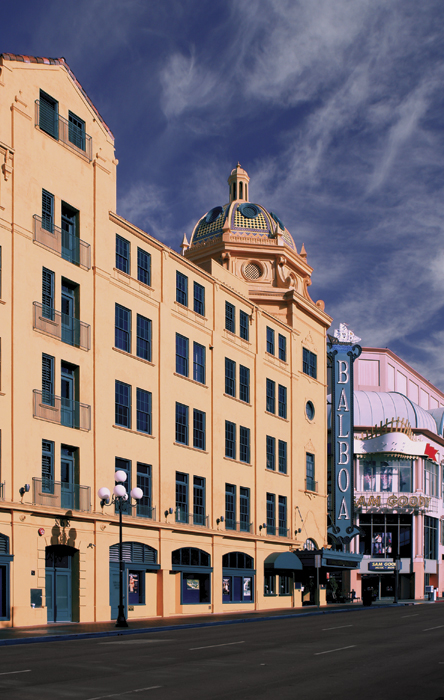|
The Balboa Theatre
An 18-year redevelopment battle
By Welton Jones
The Balboa Theatre, now contiguous with the Horton Plaza Shopping Center, opened March 28, 1924, at the southwest corner of 4th and E Streets. The Balboa was the city's first big downtown theater built for the exploding popularity of motion pictures.
A well-designed combination stage and screen house from the era of palatial theaters, this 1,500-seat, single-balcony playhouse has fine acoustics, a commodious orchestra pit, a stage the size of most Broadway stages, a high and wide stage house for hanging scenery, a spacious assortment of dressing rooms and even a pair of live waterfalls on either side of the proscenium arch.
Designed by architect William Wheeler, himself a sometime stage performer, the Balboa was owned and operated by Robert E. Hicks, a former Colorado newspaperman and columnist for the San Diego Union, who also was involved with the Plaza and Cabrillo theaters around the corner on Horton Plaza.

The Balboa Theatre, 2008. Photo by Sandé Lollis
|
During the 1920s, the theater presented a mixture of vaudeville performances and films, with several shows daily. The 426-pipe Robert Morton pipe organ installed in the Balboa was built in Van Nuys in 1922 and moved to the new Fox Theatre in 1929.
The Balboa was remodeled for sound pictures in 1930, when a new neon marquee was added, and soon became the city's leading venue for Spanish-language films and stage shows. After 1932, however, the theater was used mainly as a film house on "the wrong side of Broadway" with occasional stage shows.
In 1959, when the Balboa was to be razed in favor of a parking lot, it was purchased by the Russo Family Enterprises, remodeled and operated by the Fox chain. The Russo family took over its operation in 1976 and eventually leased it to Walnut Properties, which operated the Paris Pussycat Theatre nearby. Though no X-rated films ever were shown at the Balboa, its management by Walnut further tarnished its reputation at a time when downtown theaters were being demolished wholesale in the name of redevelopment.
Architects of the Horton Plaza Shopping Center incorporated the Balboa's distinctive tiled dome into the general look of the shopping center, thus guaranteeing that the exterior, at least, would survive. The City bought the Balboa in 1986 through condemnation, but a scheme to gut the theater and turn it into an art museum floundered. After that, years passed with various failed attempts to restore the theatre. The Centre City Development Corporation provided minimum maintenance and a handful of boosters sustained interest until, at last, the desirability of a restored Balboa Theatre became obvious to all. Today the result, one of the most skillful, attractive, useful and sophisticated theatre restorations in the country, speaks for itself and brings credit to CCDC, the City of San Diego and everyone involved.
Editors note: After an 18-year redevelopment battle, and a five-year, $26.5-million restoration, the Balboa Theater again houses live performances open to the public. While there was a cast of many who helped preserve and protect the Balboa Theatre all along the way including representatives from SOHO, it was Steve and Mary Karo who founded Save Our Balboa Organization and kept the momentum moving. Through its receiving placement on the National Register of Historic Places to its now secure future, it is an irreplaceable piece of San Diego's heritage.
|
MORE FROM THIS ISSUE
From the Editor
The Balboa Theatre - Anatomy of a Restoration
The Balboa Theatre - An 18-year redevelopment battle
Survivors of San Diego's Theatrical Past
Professional Theater Comes to San Diego
Googie: An Architectural Link to San Diego's Midcentury Culture
North Park's Neon
A General Plan of Destruction
Unearthing Long-Buried Whaley House Cistern
Preservation Community
Reflections
Lost San Diego
Strength in Numbers
Donations 2007-2008
Advertisements
DOWNLOAD full magazine as pdf (16mb)
|




